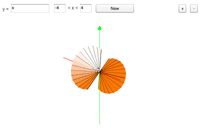Precalculus and Discrete Mathematics
Main goal: The main goal of Precalculus and Discrete Mathematics is to integrate the major ideas of mathematics needed for the future study of calculus and to present the fundamental notions of discrete mathematics.
Main theme I: To prepare students for calculus, broad ideas related to all continuous functions; and specific ideas related to polynomial, rational and trigonometric functions, and sequences and series are discussed. Limits are used in informal introductions to the derivative and the integral. Students are expected to be competent at proofs involving trigonometric identities. Two- and three-dimensional vectors are discussed to prepare students for applications of calculus to the sciences.
Main theme II: Discrete mathematics includes logic and mathematical reasoning, mathematical induction and recursion, combinatorics, the analysis of networks, and systematic sorting methods that are important in computer science, business, economics, and the biological sciences. Students are expected to be competent at proofs involving mathematical induction.
Main theme III: The structure of Precalculus and Discrete Mathematics enables ideas from discrete mathematics and continuous functions to play off of each other in productive ways. Formal mathematical reasoning, needed for success in college mathematics courses, begins with the study of logic in the first chapter. Logic has direct applications not only to computer games and decision-making, but also to the proof techniques students are expected to employ throughout the book. Analogies are made between the structures of integers (discrete) and polynomials (continuous), between rational numbers and rational functions, and between difference equations and derivatives. Recursion and mathematical induction are intimately related. Discrete rates of change and sums are extended to introduce the ideas of derivatives and integrals.

Finding the two-dimensional graph of a polyhe- dron by using the shadow a wireframe model of the polyhedron casts on a tabletop
Comparison between this and earlier editions: The content of this course is relatively the same as in prior editions, but there is more work with vectors, parametric equations, polar coordinates, and complex numbers. Some work on trigonometry has been integrated into these lessons and into the study of algebraic fractions. Derivatives are studied earlier.
Some distinctive lessons: Sequences and a limited growth model (2-7); The logic of equation-solving (3-4); Prime numbers and prime polynomials (4-5); Algorithms for sorting lists (6-8); Acceleration and deceleration (7-4); What exactly are you counting (12-1); Walk lengths and minimum paths (13-5). Lessons 4-5, 9-5, and 14-7 discuss the Fundamental Theorems of arithmetic, algebra, and calculus, respectively.
Contact
UCSMP
1427 East 60th Street
Chicago, IL 60637
T: 773-702-1130
F: 773-834-4665
ucsmp@uchicago.edu




